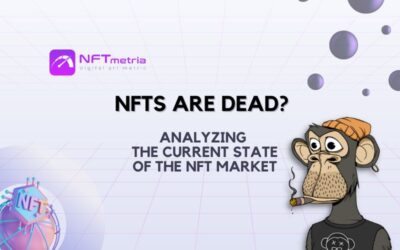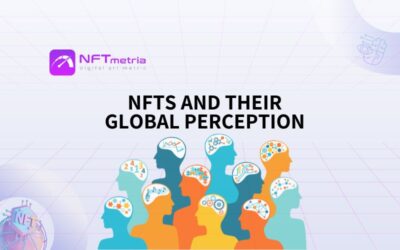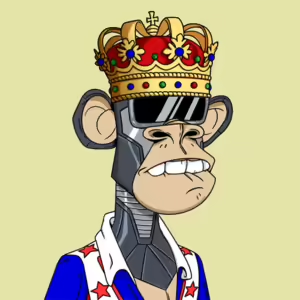The remarkable ascent of Non-Fungible Tokens (NFTs) can be traced back to their introduction in 2014. Since then, they have captured the imagination of artists, collectors, and investors alike.
However, this newfound enthusiasm surrounding NFTs has not been without its fair share of controversies.
In recent months, the NFT sector has experienced a significant downturn marked by a decline in sales and item prices. What was once a flourishing market, with staggering sums spent on popular NFT collectible projects, appears to have lost its momentum.
Brands that hastily joined the NFT bandwagon are now reevaluating their short-term objectives. With the crypto market sentiment remaining bearish, the NFT landscape seems to be at a crossroads.
In this article, we will delve deeper into the current state of NFTs, analyzing the factors that have contributed to the market’s decline. We will explore the arguments for and against NFTs, examining potential growth opportunities and the challenges ahead. Ultimately, we will attempt to answer the burning question: Are NFTs dead, or are they simply weathering a temporary setback?
The Hype and Initial Success
The concept of NFTs gained traction by introducing scarcity and value to the digital world.
The NFT market witnessed a surge in high-profile sales that garnered global attention in the latter half of 2021. Particularly, Beeple‘s digital artwork, titled “Everydays: The First 5000 Days,” sold for a staggering $69 million, thrusting NFTs into the mainstream. This unprecedented sale underscored the potential for digital art to command significant value in the market.
Another noteworthy example is Pak‘s “The Fungible Collection,” featuring the iconic “Clock” piece, which sold for $52 million. These high-profile sales solidified NFTs’ position as a lucrative investment opportunity.
Furthermore, the role of celebrities and influencers in promoting NFTs played a crucial role in driving the initial hype and popularity of NFTs. Prominent figures like Eminem and Jimmy Fallon openly endorsed NFT projects like Bored Ape Yacht Club (BAYC), generating widespread attention.
During the same period, the rise of NFT marketplaces, such as OpenSea and Rarible, facilitated the buying and selling of NFTs, fueling the interest and participation of seasoned collectors and newcomers. The NFT space garnered so much attention that the NFT volume on OpenSea exceeded $184 million in a single day, with more than 43,000 active users.
The Rise and Fall of NFTs: Understanding the Reasons Behind the Decline
Eventually, the euphoria waned, leading to a significant decline in the NFT market.
Ethereum NFT mintings fell from 373,000 on July 10, 2022, to 3,590 on July 1, 2023.
Beyond the broader market dynamics, several unique challenges and issues played a role in the decline of NFTs:
- The role of speculators and inflated prices: Some argue that the skyrocketing valuations of certain NFTs were fueled by speculative investors rather than genuine appreciation for the underlying art or digital assets. Moreover, the volatility and uncertainty surrounding NFT prices contributed to market instability and risk.
- Rise in scams and fraud in the NFT market: With the exponential growth of the NFT sector, numerous smaller projects emerged, some of which turned out to be scams. Investors and collectors fell victim to “rug pulls,” where creators abruptly exited scams, leaving participants with worthless or non-existent NFTs. These incidents fostered a sense of distrust within the community, leading to broader skepticism about the legitimacy and reliability of NFT projects.
- Market correction factors, including oversaturation: Oversaturation played a pivotal role in the market correction of NFTs. During the peak of the NFT frenzy, numerous projects inundated the market with a plethora of digital assets. This inundation made it challenging for investors and collectors to differentiate between high-quality NFTs and less valuable ones.
- Regulatory scrutiny of NFT platforms and transactions: Governments worldwide grappled with how to regulate these digital assets, and new laws and regulations could have implications for NFT platforms and transactions. The prospect of increased regulation created a sense of caution among investors, further contributing to the market correction.
As a result of all these factors, the NFT market experienced a significant downturn, marked by a decline in both sales and prices. For instance, in January 2022, Justin Bieber purchased a Bored Ape NFT for $1.31 million. Currently, it is worth less than $59,000.
The total NFT market trading volume fell from $10.7 billion in Q4 2022 to $4.7 billion in Q1 2023, representing a staggering 53% drop, according to a DappRadar report.
Are NFTs Dead?
By examining the current state of the NFT market and comparing it to historical performance, we can determine whether NFTs are dead or still thriving.
After experiencing a decline in trading volume for several months, there was a notable reversal in January, with a 38.5% increase compared to the previous month. This trend continued in February, with trading volume reaching a staggering $2 billion, an increase of 111% from the previous month. This spike in trading volume was largely driven by the emergence of Blur, a new marketplace that quickly gained momentum within the NFT ecosystem, and the emergence of BRC-20 NFTs.
Interestingly, despite a decrease in the number of sales from 9.2 million in January to 6.3 million in February, the average sale price of NFTs rose to accommodate the substantial increase in trading volume.
Despite February’s impressive spike, it falls short of January 2022’s record-breaking month, when over $5.5 billion worth of NFTs were traded across major markets. Nevertheless, the recent resurgence in trading volume and the presence of new marketplaces demonstrate that there is still life and potential for growth in the NFT market.
Future of NFTs
While the NFT market undergoes a correction and moves away from its initial speculative hype, the future of NFTs remains promising. Furthermore, advancements in blockchain technology, such as Ethereum‘s Layer 2 solutions, enhance NFT accessibility by reducing environmental impact and transaction costs.
Looking ahead, the unique utility of NFTs in establishing ownership and authenticity in the digital world presents countless innovative applications across industries. Here are a few potential uses:
- Digital Identity Verification: NFTs could be used to represent digital identities, enhancing the safety and reliability of online interactions. This technology has the potential to prevent fraud and secure digital transactions.
- Supply Chain Management: By attaching NFTs to goods, consumers can verify their authenticity and trace their origin and journey through the supply chain, promoting transparency and trust.
- Decentralized Finance (DeFi): NFTs can be used as collateral for loans or to represent shares in investments, expanding the possibilities of DeFi.
- Virtual Real Estate and Metaverse: As the metaverse concept develops, NFTs will be used increasingly to own and trade virtual land, buildings, and other assets in virtual worlds like Decentraland and Cryptovoxels.
- Intellectual Property Rights: NFTs could change how intellectual property is bought, sold, and managed by representing ownership of patents, trademarks, and copyrights.
- Gaming: NFTs allow players to own and trade in-game assets independently of game developers, monetizing their virtual skills.
- Music and Entertainment Industry: Artists and creators can leverage NFTs to directly sell music tracks, videos, or exclusive experiences to fans, enabling greater control and direct interaction with their audience.
NFTs are not dead, but evolving
The potential for NFTs to become more popular in the future is significant. Factors such as infrastructure development, the scarcity of NFTs, diversification opportunities, growing adoption in different sectors, and increasing acceptance by mainstream artists and brands all contribute to the potential for the NFT market to recover and thrive.
Yes, NFTs have experienced a downturn, but they are definitely not dead. The bottom line is that we are at the beginning of the NFT journey and the market is maturing: we expect to see a future where many things become NFTs.
The future of NFTs is not just about digital art or collectibles. It is about reshaping industries, rethinking digital identities, and creating new economic and social paradigms.











